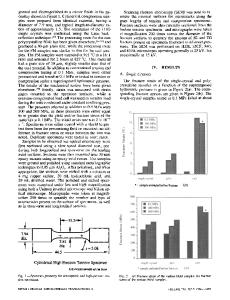Solidification Modeling of NiAl Single Crystal Castings
- PDF / 2,493,909 Bytes
- 6 Pages / 420.48 x 639 pts Page_size
- 7 Downloads / 323 Views
SOLIDIFICATION MODELING OF NiA1 SINGLE CRYSTAL CASTINGS
K.O. YU*, J.A. OTI* AND W.S. WALSTON** *PCC Airfoils, Inc., 23555 Euclid Avenue, Cleveland, OH 44117 **GE Aircraft Engines, I Neumann Way, MD 85, Cincinnati, OH 45215
ABSTRACT Solidification conditions of a 0.64 cm x 2.5 cm x 15.2 cm slab and a 1.3 cm 0 x 15.2 cm bar were simulated for two NiAI alloys. Simulation results were correlated with experimental inspection results to establish a relationship between dendrite arm spacing and local solidification time. The results were also used to construct a defects map for NiAl single crystal castings. Results have been compared to a similar model for single crystal nickel-base superalloys. INTRODUCTION NiAl is one of the most promising intermetallic systems for replacing superalloys as a high temperature structural material in high performance jet engines. While considerable work is being done on developing and optimizing the properties of NiAl alloys, relatively less attention is being paid to the production-scale processing of these alloys. For single crystal components, the investment casting process appears to be the only viable approach. However, because of their higher melting temperatures, higher thermal conductivities, higher ductile-to-brittle-transition temperatures, and lower room temperature ductilities than those of nickel-based superalloys, modifications of the investment casting process from that producing superalloy single crystals are required to produce NiAl single crystal components. Finite-element thermal modeling offers the capability of simulating casting heat transfer conditions and understanding the solidification sequence. As a result, it provides valuable information regarding the investment casting processing of NiA! single crystals. Efforts were undertaken at GE Aircraft Engines andat PCC Airfoils to simulate the solidification conditions of cylindrical bars and slabs, correlate dendrite arm spacing with local solidification time (DASLST) and construct a defects map for two selected NiAl alloys. The approach combined finiteelement thermal analyses and experimental casting results. The purpose of this paper is to document results from these studies. EXPERIMENTAL CASTINGS Two NiAI alloys were cast in two clusters (one for each alloy) of variously shaped bars, slabs and generic airfoils at specified furnace temperatures and withdrawal speeds. Thermocouples were placed at selected locations in the mold to record the metal and shell temperatures as a function of time. After shake-out of the mold, all castings were inspected for grain defects. Several pieces of castings were cut to measure the primary and secondary dendrite arm spacings (PDAS and SDAS). FINITE-ELEMENT MODELING The modeling approaches are described in References 1-3. Two casting simulation models (one for 1.3 cm diameter bar and one for 0.64 cm x 2.5 cm x 15.2 cm slab) were built. Figure 1 shows the finite-element model for the slabs. Due to symmetry, it was only necessary to model one slab on the mold to simulate the entire c
Data Loading...











